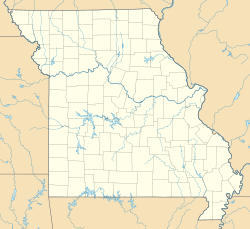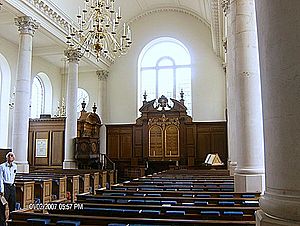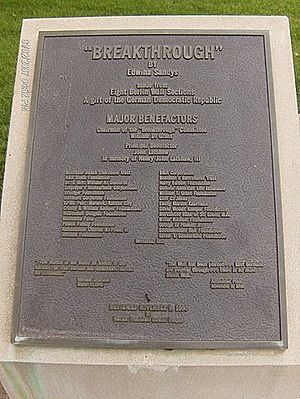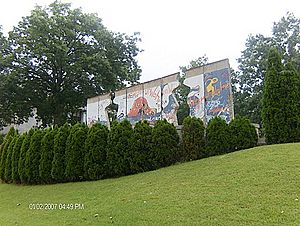National Churchill Museum facts for kids
Quick facts for kids |
|
|
Winston Churchill Memorial
|
|
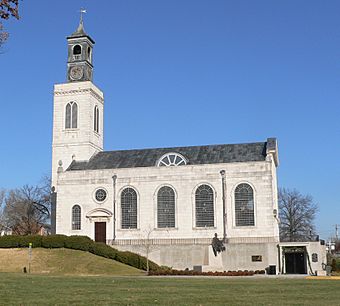
View from the south
|
|
| Location | Fulton, Missouri |
|---|---|
| Built | 1677 |
| Architect | Christopher Wren |
| Architectural style | Renaissance Classical, English Baroque |
| NRHP reference No. | 72000708 |
| Added to NRHP | March 16, 1972 |
America’s National Churchill Museum is a special place in Fulton, Missouri, United States. It is located on the campus of Westminster College. This museum honors Sir Winston Churchill, who was a very important leader. He served as the Prime Minister of the United Kingdom during World War II.
The museum has three main parts. These include the Church of St Mary Aldermanbury, the museum galleries, and a sculpture called Breakthrough. The church itself has an amazing story. It was first built in London, England, in 1677. It was designed by a famous architect named Christopher Wren. After being damaged in World War II, the church was carefully taken apart. Each stone was moved across the ocean and rebuilt in Missouri in the 1960s.
Contents
The Church of St. Mary, Aldermanbury
The most important part of America’s National Churchill Museum is the Church of St. Mary, Aldermanbury. This church is from the 17th century. It was moved stone by stone from London, England, to Fulton, Missouri.
Beneath the church building, you will find the Churchill museum. This museum was updated in 2006. Its exhibits share Churchill's life story. They cover his personal life, his political career, and his lasting impact on the world. There is also a special reading room. It has many books and documents about Churchill for people who want to do research.
Why the Church Was Moved
In 1961, the president of Westminster College, Dr. Robert L. D. Davidson, wanted to create a memorial for Winston Churchill. He also wanted to remember Churchill's famous "Sinews of Peace" speech. He saw an article in LIFE magazine about churches in London that were damaged in the war. These churches were going to be torn down. This gave him the idea to move one of them to the college. It would serve as both a memorial and a chapel for the college. After looking into it, college officials chose St. Mary, Aldermanbury.
A Church with a Long History
St. Mary, Aldermanbury was chosen because it was not too big. It also had a history of almost 1,000 years. The church was first built in the late 1100s. It survived many big events in English history. These included the English Reformation and the English Restoration.
However, on September 2, 1666, the church was destroyed. This happened during the Great Fire of London. Permission to rebuild was given in 1670. The architect Christopher Wren began rebuilding the church in 1672. He used parts of the old foundation and as many original stones as possible. The work was mostly finished by 1677. A dome-like top, called a cupola, was added to the tower in 1679.
Damage During World War II
On December 29, 1940, during World War II, German planes attacked London. This was part of the "Blitz." St. Mary's was directly hit by a fire bomb. This caused it to burn down again. After the war, many destroyed churches were not rebuilt. St. Mary's remained a ruin for 20 years. It was then planned for demolition along with other London churches.
At this point, Westminster College stepped in. They stopped the demolition of St. Mary's. They decided to rebuild it in Missouri to honor Winston Churchill. It took four years to plan the project. They also needed to raise $2 million, which would be more than $10 million today. The famous actor Richard Burton helped a lot. He appeared on The Tonight Show to ask for donations.
Rebuilding the Church in Missouri
In 1965, the process of moving St. Mary's began. Workers carefully labeled each of the 7,000 stones. They noted where each stone belonged in the church. More than 700 tons of stone blocks were shipped to Fulton by boat and train. During shipping, the stones got mixed up. This made rebuilding the church very difficult.
The first stone for the new foundation was placed in October 1966. By May 1967, the last stone was in place. However, it took two more years to finish the inside of the church. English woodcarvers used old photos to recreate the carvings. These were for the pulpit, the baptismal font, and the balcony. An American company, Blenko Glass Company, made the glass for the windows. A Dutch company made five new bronze bells for the tower. Noel Mander, who saw St. Mary's burn in 1940, built the organ. He also helped make sure the inside details were correct. There were only two small changes from Wren's original design. These were an organ gallery and a window in the tower for light.
The dedication ceremonies for St. Mary's and the Winston Churchill Memorial and Library happened on May 7, 1969. During the event, the Rev. Anthony Tremlett, a bishop from England, made St. Mary's a place of worship again. In 1992, a group called the Eagle Squadrons Association named St. Mary's their official chapel. In 2009, the United States Congress officially named the museum “America’s National Churchill Museum.”
Winston S. Churchill: A Life of Leadership Gallery
The museum tells the story of Churchill's life. The exhibition starts with his birth. It then moves through the major events of his life. It also shows how these events connect to important moments of the 20th century.
World War I Experience
One key part of the museum is the "Admiralty, Army & Arsenal: 1914–1919" room. This area looks like a World War I trench. It has barbed wire, sandbags, and empty ammunition shells. This helps visitors understand what it was like for a British soldier. A periscope on the trench wall lets visitors see a real World War I battlefield from old videos. You can also hear sounds of soldiers talking and distant gunfire. This room also explains Churchill's role in the Dardanelles and Gallipoli disasters. It also shows his contributions to new war technology.
Churchill's Warnings Before World War II
Another part of the exhibition is "The Gathering Storm: 1929–1939" room. This room talks about Churchill's concerns about Adolf Hitler and the Nazi movement. In this room, five video screens show parts of Nazi propaganda films. These are mixed with images of the coming war. The exhibit explains Churchill's views on the Nazis. It also shows his dislike for Britain's pre-war appeasement politics.
World War II and the Blitz
Another room, "Churchill's Finest Hour: World War II, 1939–1945," shows World War II and Churchill's role. It has a sound and light show that recreates an air raid on London during the "Blitz." It includes fake rubble, sounds of bombs and air raid sirens. There are also flashing lights that look like searchlights and anti-aircraft fire. You can hear audio clips from wartime radio broadcasts. After this "Blitz" show, a short film explains Churchill's role as prime minister during the war. It is narrated by Walter Cronkite. Other interactive displays teach about code breaking and plane spotting skills from the war.
Churchill's Speeches and Wit
Other parts of the museum include "The Sinews of Peace" room. This room tells the story of how Churchill came to speak at Westminster College. You can see the lectern and chair Churchill used for his speech. You can also see the special robes he wore. In "Winston's Wit & Wisdom" room, visitors can sit in a room that looks like a British club. They can listen to stories about Churchill. Visitors can also look through a database of Churchill's most famous quotes and jokes.
"The Sinews of Peace" Address
In 1946, the president of Westminster College, Franc McCluer, contacted someone in U.S. President Harry S Truman's team. This person, a former student of Westminster College, helped arrange for Truman to visit the college. He also helped invite Winston Churchill to speak there. Churchill accepted the invitation. On March 5, 1946, he gave his famous "Sinews of Peace" speech. This speech is also known as the "Iron Curtain" speech. President Truman was there to hear it.
Today, visitors to the museum can watch parts of this speech on film. The lectern and chair that Churchill used are on display in the museum.
Breakthrough Sculpture
On November 9, 1990, Edwina Sandys, Winston Churchill's granddaughter, showed her sculpture Breakthrough to the public. This sculpture is at America’s National Churchill Museum. It is made from eight sections of the Berlin Wall. Breakthrough remembers the fall of the Berlin Wall. It also honors Churchill's "Sinews of Peace" speech.
In 1990, with help from Westminster College, Sandys and her husband, Richard Kaplan, went to East Berlin. They wanted to get parts of the wall. When they arrived, they realized the sculpture would be very expensive. Sections of the wall were selling for $60,000 to $200,000. However, officials from East Germany liked the idea of a Berlin Wall monument. They liked that it would be at the place of Churchill's 1946 speech. So, they gave Sandys eight sections of the wall as a gift to Westminster College.
Sandys chose the sections from an area near the Brandenburg Gate. This area was popular with artists. She liked the bright colors of the graffiti. She also liked that the word "unwahr" (meaning "lies" or "untruths") was used many times in the sections. Sandys changed the original sections. She cut out large shapes of a man and a woman from the wall. These shapes represent the new communication between East and West Germany. When put together, Breakthrough is about 11 feet tall and 32 feet long. The cut-out shapes are part of another sculpture called Breakfree. This second sculpture is at the Franklin D. Roosevelt Presidential Library and Museum in Hyde Park, New York.
One year after the Berlin Wall fell, Sandys showed Breakthrough to a crowd of 7,000 people. They gathered on the campus of Westminster College.
Lecture Series at the College
Since 1937, Westminster College has hosted two important lecture series. These are the John Findley Green Lectures and the Crosby Kemper Lectures. Both series have brought many famous politicians, business leaders, and scholars to the college.
The John Findley Green Foundation Lectures started in 1936. They honor John Findley Green, a lawyer who graduated from Westminster College in 1884. This foundation supports lectures that help people understand global economic and social issues. The Crosby Kemper Lecture Series began in 1979. It was started with a grant from the Crosby Kemper Foundation. This foundation provides for lectures by experts on British History and Sir Winston Churchill at America’s National Churchill Museum.


